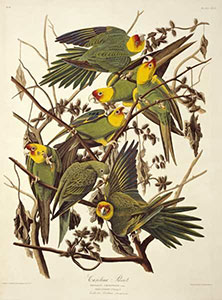Departure and Arrival: The Sad, Strange Tale of Two American Parakeets
Opinion Advocates for ideas and draws conclusions based on the author/producer’s interpretation of facts and data.

By Brian Kluepfel
The last Carolina parakeet died 104 years ago. Perhaps fittingly, it died in a zoo. Humans had wiped out all the wild birds of this species several years before.
On this cold winter’s day, I pay tribute to this beautiful bird, amazed, indeed that we once had wild parrots in New York.
I look around the woods of my native New York and see jays, cardinals, various woodpeckers and goldfinches, birds of varying color, beauty and variety. It’s mind-blowing to think, though, that if I had been born 100 years earlier, I might have grown up seeing endemic parrots among these trees.
The Carolina parakeet was a beautiful bird, and one of just two parrots native to North America. The other species, the thick-billed parrot, is now restricted to Mexico. (No report on how partially completed wall construction will affect its mobility.)
The Carolina parakeet was about 30 centimeters long (18 inches) and its plumage displayed shades of green, yellow and red. It foraged on a variety of wild feed, like burgess seeds, thistle seeds, wild grapes, berries and poisonous cockleburs, but as humans destroyed its natural feeding sources, the parrot turned to crop eater, and this was another misfortune of their evolution. Naturally gregarious, they were easily shot-gunned by the hundreds by farmers protecting crops, which replaced the birds’ former diet.
The Carolina’s striking coloration was another grave evolutionary offense. People collected them as pets, and in captivity the birds hardly reproduced; humans also gathered just the feathers to make adornments for hats (and killed the birds in the process. The feathers, to be kind, were not gently plucked from living birds who were then allowed to fly free.)
The rarer the birds got, the more voracious its collectors. By 1910, or thereabout, there were none left in the wild. In 1918, Incas, the last surviving male, died of heartbreak, so it’s said, shortly after his female partner, Lady Jane, went on to the avian hereafter. Appropriately, Incas died in the same cage where the last passenger pigeon, Martha, perished, four years prior. (Note to birds: avoid the Cincinnati Zoo.)
If only the Carolina had flown south like its cousin, the thick-billed parrot, maybe there’d still be some left. But the fact that we knew of its imminent demise and still allowed it to occur, is a real blot on our species (humankind, for those of you keeping score at home).
If you really want to see wild parrots in New York, there is a flock of monk parakeets in Brooklyn’s Green-wood Cemetery. A bunch of these South American natives were somehow released in New York in the 1960s, and these adaptable birds, like many others before them, are now naturalized Americans.
Brian Kluepfel is an Ossining-based writer and encourages you to join Saw Mill River Audubon on any and all of their online and in-person adventures listed in the ad below or at www.sawmillriveraudubon.org.

Examiner Media – Keeping you informed with professionally-reported local news, features, and sports coverage.
